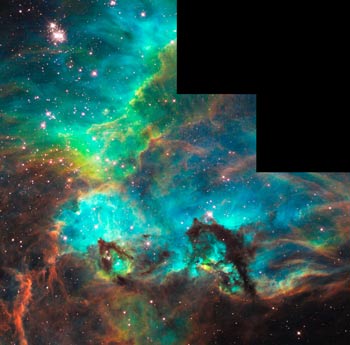







| BOOKS | F. A. Q. | ARTICLES | TALKS | ABOUT KEN | DONATE | BEYOND OUR KEN |
|---|
By Ken Croswell
Published in New Scientist (August 13, 2009)

The Large Magellanic Cloud, shown here, may have a rival. Image by the Hubble Space Telescope [NASA, ESA, and M. Livio (STScI)].
A large satellite galaxy may be lurking, hidden from view, next
door to our own.
Sukanya Chakrabarti and Leo Blitz of the University of California, Berkeley, suspected that the gravity of a nearby galaxy was causing perturbations that have been observed in gas on the fringes of the Milky Way. "We did a large range of simulations where we varied the mass of the perturber and the distance of closest approach," says Chakrabarti. In the best-fitting simulation, the unseen galaxy has about 1 per cent of the Milky Way's mass, or 10 billion times the mass of the Sun.
That's a lot. It means the object has roughly the same mass as the Milky Way's brightest satellite galaxy, the Large Magellanic Cloud (LMC).
 Right now, says Chakrabarti, the galaxy is roughly 300,000
light-years away from us--about twice as far away as the Large
Magellanic Cloud. But the simulations suggest it follows
a highly elongated elliptical path, and about 300 million years
ago it swept through our own Galaxy just 16,000 light-years from
the Galactic center--closer in than Earth--disturbing the Milky
Way's outskirts as it went.
Right now, says Chakrabarti, the galaxy is roughly 300,000
light-years away from us--about twice as far away as the Large
Magellanic Cloud. But the simulations suggest it follows
a highly elongated elliptical path, and about 300 million years
ago it swept through our own Galaxy just 16,000 light-years from
the Galactic center--closer in than Earth--disturbing the Milky
Way's outskirts as it went.
"Overall, it's a very plausible scenario," says Abraham Loeb at the Harvard-Smithsonian Center for Astrophysics in Cambridge, Massachusetts, who was not part of the study. "Of course, the fact that we don't see such a massive satellite is an issue."
Chakrabarti suggests that the galaxy has remained hidden because it is not a brilliant spectacle. Whereas the Large Magellanic Cloud glistens with bright young stars and the gas that spawned them, the unseen galaxy may be dead, containing old stars and little gas.
To make matters worse, the simulations suggest that the galaxy orbits ours in the same plane as our Galaxy's disk. If it is now on the opposite side of the Galaxy from us, it could be hiding behind the thick gas and dust in the Galactic plane. "It's very likely to be in a region of very high obscuration," says Chakrabarti. The work will appear in Monthly Notices of the Royal Astronomical Society.
By further studying the distribution of gas, Chakrabarti hopes to pinpoint the galaxy's location so that astronomers will know where to look for it. This parallels the way astronomers in the 1840s discovered Neptune from irregularities in the motion of Uranus caused by gravitational tugs from the more distant planet.
If the unseen galaxy exists, it will be the first nearby galaxy detected through its gravity rather than its starlight.
Ken Croswell is an astronomer and the author of Magnificent Universe and Ten Worlds.
"Magnificent Universe by Ken Croswell is elegant and eloquent."--Washington Post. See all reviews of Magnificent Universe here.
"On the basis of its striking design and photographs, this handsome, large-format volume is well worthy of praise. And astronomer Croswell's concise yet conversational, information-packed text wins it sky-high accolades in the narrative sphere as well."--Publishers Weekly, starred review. See all reviews of Ten Worlds here.
| BOOKS | F. A. Q. | ARTICLES | TALKS | ABOUT KEN | DONATE | BEYOND OUR KEN |
|---|